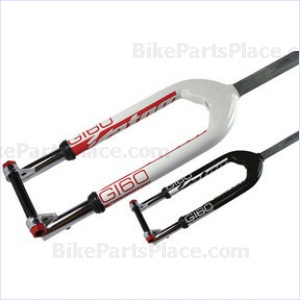 A suspension fork is important because they increase your control when you hit rough spots. Without a suspension forks as soon as you hit any bumps your whole body tightens ups as you try to keep it together. With front suspension you are able to recover more quickly because the bike suspension absorbs a portion of the turbulence. Front suspension forks can also completely prevent some types of accidents. I can think of several instance in which my front wheel hit and unyielding object particularly hard and I knew that my body absorbed 100% of the what it could handle. If the suspension fork had not absorbed the rest I would have gone over my handle bars and be laying on the ground. The draw back to suspension is that it will absorb some of your good pedaling energy so more is not always better.
A suspension fork is important because they increase your control when you hit rough spots. Without a suspension forks as soon as you hit any bumps your whole body tightens ups as you try to keep it together. With front suspension you are able to recover more quickly because the bike suspension absorbs a portion of the turbulence. Front suspension forks can also completely prevent some types of accidents. I can think of several instance in which my front wheel hit and unyielding object particularly hard and I knew that my body absorbed 100% of the what it could handle. If the suspension fork had not absorbed the rest I would have gone over my handle bars and be laying on the ground. The draw back to suspension is that it will absorb some of your good pedaling energy so more is not always better.
The right amount can vary a lot and you have to decide what you need based on the environment you will be riding, (how aggressively you ride, road conditions, and how often you will be riding on long flat stretches of road with wide bike lanes.
A front suspension fork with about two inches of travel on a hard tail frame will make a big difference. Sometimes a suspension fork with as little as ½” of travel would be ideal. It seems that a small amount of passive shock absorption is all that is needed for certain types of riding such as taking the edge off of rolling down a curb. This idea reminded me of the original Manitou suspension forks. You adjusted the resistance on these forks by opening them up and swapping out small rubber bumpers (spring like) about the diameter of a nickel and about 1″ long that compressed. Since suspension fork technology has come so far it seems that it would be possible to make a fork that had a super slim profile that was no more bulking then rigid forks but made using these simple rubber shocks. Oil shocks, spring shocks, lock out, and on the fly adjustments require more internal mechanisms. If the fork only made use of these rubber shocks the fork would not require anything nearly so bulky as a typical fork. It could be a suspension fork that looks and weighs as much as a rigid fork. So since I know of no such suspension fork the alternative is to look for a fork with the least amount of travel and weight or maybe a carbon fiber fork.
The other extreme is that I can think of times where rear suspension is beneficial. When riding in traffic there is an incentive to keep up with the flow of traffic because you have less control of the situation when you are being pasted by because it makes what is going on behind you more important as what is going on in front of you. So it happens sometimes that there is an oncoming obstacle that needs to be hopped over that is only three inches off the ground. Well it is easy enough to pull up your front end to clear the object at 20 MPH but to actually hop both tires and completely clear can feel pretty sketchy. Bunny hopping the whole obstacle feels is something is a nerve racking move since the consequence of failure is sever. In a slight way you need to preload your front end at the start of the bunny hop move. Also your weight is centered equally on average over both wheels. By comparison when you only need to be concerned with your front end clearing the bump you can keep your weight over your rear wheel the whole time. This means that in the process of bunny your weight shifts over your front fork so that if you botch your timing you will have most of your weight over your front wheel just as it hits the object which guarantees you are about to get thrown over your handle bars and off your bike. The result of all this is that I tend to be more concerned with my front fork then with the rear end. With a hard tail if you hit your rear wheel on even a small bump in creates a pogo effect on your rear end which will also cause you to be throw you over your handlebars. Rear suspension will absorb and can offset some of the pogo effect, hopefully prevent a fall. Front and rear suspension will improve your control and the chance that you will be able to recover from a rough spot that would not always be possible with a rigid fork and bike frame.


 Shopping
Shopping


